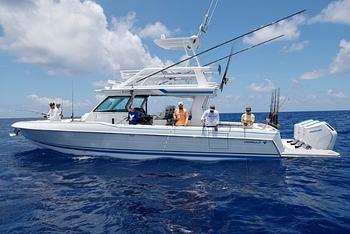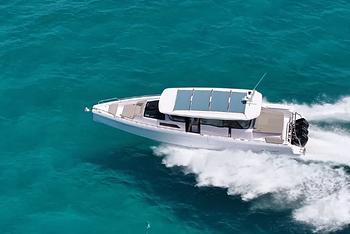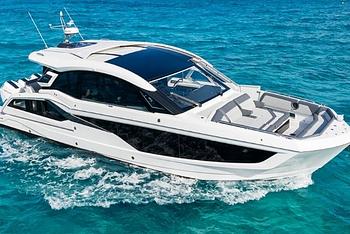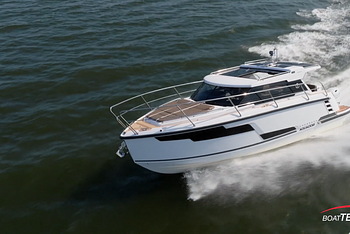If you’re shopping for a Lagoon 450 sailing catamaran on the pre-owned market, you’ll find one basic model in two flavors that were launched at two different times. The Lagoon 450 F was the first to launch in 2010 and was a full flybridge model which replaced the popular Lagoon 440. The Lagoon 450 S was built on basically the same hull and was introduced in 2017. It was called a “SporTop” which had a sedan style profile and no flybridge. When buying used, you have choices but be sure you know which you’re getting.

The Lagoon 450F has a flybridge for the helm station, bench seating, and a sunpad. Lagoon photos
Lagoon 450 Key Features
Naval architects Marc Van Peteghem & Vincent Lauriot-Prévost (VPLP) designed the 450 F with a flybridge and an off-center helm. A few years later, the deck helm mold was modified. Without the flybridge, the 450 S gained a lower profile and slightly less windage as well as new hull windows. The coach house remained the same with vertical saloon windows that define Lagoon’s signature look. The helm stayed to starboard but was lowered and added a sliding “gate” on the outboard edge for added security underway. With the gate open, the skipper can quickly step out onto the side deck to help with dock lines. This gate as well as the small top that protected the helm were options so not all models on the secondary market will have them.
On both models, steps lead from the cockpit to the starboard deck, but that’s where things change. The “F” has a second set of steps that lead from the port deck up to the other side of the long flybridge seat. The SporTop did away with the secondary steps as well as with the long flybridge bench and instead added steps up from the helm to a sunbed on the hardtop. The traveler remained connected to the aft end of the Bimini on both versions.
Both models featured two cockpits, one forward and one aft. When swinging on anchor in eastern trade winds, the aft cockpit gets hot in the afternoon sun and that’s when the forward cockpit shines. With a U-shaped settee that is integrated into the foredeck just aft of the twin trampolines, this is the place to lounge in the shade. Meanwhile, the aft cockpit accommodates 6-8 for dinner at the portside U-shaped settee that wraps around the dining table. Additional seating is to starboard on a double lounge and an outdoor refrigerator was optional but makes a nice addition if you can find a model with it.
The swim platforms on both versions are short with the hull-side coamings swooping down to the very end of the transoms. It makes boarding from a side dock tricky because there’s little room there to place your foot.
The exterior flows well to the interior especially with the aft window and glass door open. Inside, an L-shaped settee with table is to starboard and faces aft for a good view of the TV that rises from a cabinet by the door. The forward end of the U-shaped galley has Corian counters with molded-in fiddles and a three-burner cooktop with a separate oven. The forward end of the galley isn’t parallel with the aft end and instead is angled slightly. This creates room to open the front-loading refrigerator. A dishwasher and microwave were optional. A forward-facing nav station is just ahead of the galley in the port corner with a multifunction display and a joystick to form an inside steering station. With light matte teak cabinetry and oak flooring, Nauta Designs created a contemporary vibe.
The Lagoon 450 was available with 3-6 cabins and 3-6 heads. Charter versions were generally packed with cabins but an owner’s configuration with a large bed and an equally large head and separate shower stall were also available.
Lagoon initially offered two outfitting packages—Essential and Comfort—with additional a la carte options available. The davits for example were in the Essential pack while the Onan genset was in Comfort. I’d personally look for the whole host of equipment because on the used market, all these extras come at a significant discount.
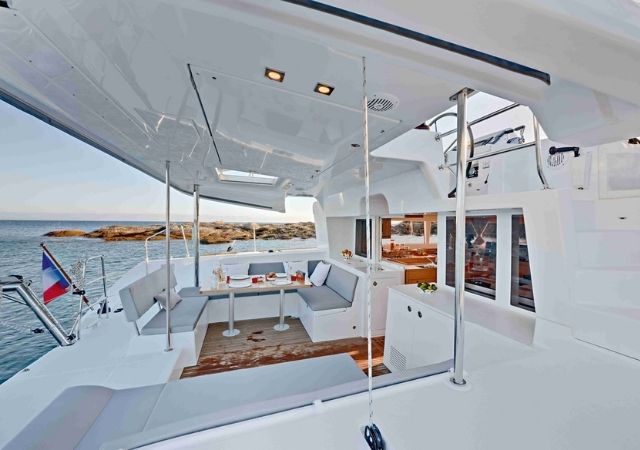
On the 450S version, the aft cockpit is three easy steps from the helm. More steps lead to the sunpad on the hardtop.
Lagoon 450 Performance
The 450 F carries 1,399 square feet of upwind sail area with the standard full batten mainsail by Incidence Sails. With a lower boom and an optional square-top main on the SporTop, the sail area grows by another 22 square feet. The Z-Spar mast is three feet shorter (73’ 3”) on the “S”versus the “F” and may reduce pitching although no data was ever collected to confirm this.
The control lines are led aft from the mast to an array of Spinlock rope clutches and three Harken winches at the helm. Visibility aft is better from the SporTop because you can duck under the Bimini to see the transoms when docking, which isn’t possible on the flybridge. A single 12-inch B&G MFD is at the helm and additional Harken winches are in the cockpit for the optional Code 0. With a decent breeze of 12-15 knots, we sailed the SporTop at 6-7 knots on a close reach of 55 degrees apparent wind angle (AWA) and at 8-9 knots on a beam reach on flat water in the same wind.
The 450 F was equipped with twin 45-hp Yanmar diesels but the 450 S added an optional upgrade to 57-hp engines. With saildrives and folding propellers, the 450 S delivered 9.1 knots at 3200 rpm (wide-open-throttle). A more efficient cruising speed was 2400 rpm and 7.8 knots. Maneuvering a catamaran at slow speed in tight quarters is easy because the engines are set far apart (25 feet in this case) and will turn the boat in its own length. With its agility under power, this big boat takes the stress out of coming into any docking situation and actually makes it fun.
Lagoon 450 Pros & Cons
There are two main pros for the Lagoon 450. First, it came in two versions so buyers today have choices. Second, it slotted perfectly into the French builder’s line with the right appeal of a platform under 50 feet. The model is spacious and durable with many charter models surviving back-to-back hurricanes in the Caribbean. They were built like battleships, which bodes well for picking up a used one now.
On the other hand, the fuel tankage of 92 gallons, which is the same on both models, is light for distance cruising yet sufficient for coastal hops and gunkholing. Also, the model is fairly heavy, and sailing at 7-8 knots won’t blow your hair back but it’ll get you there.
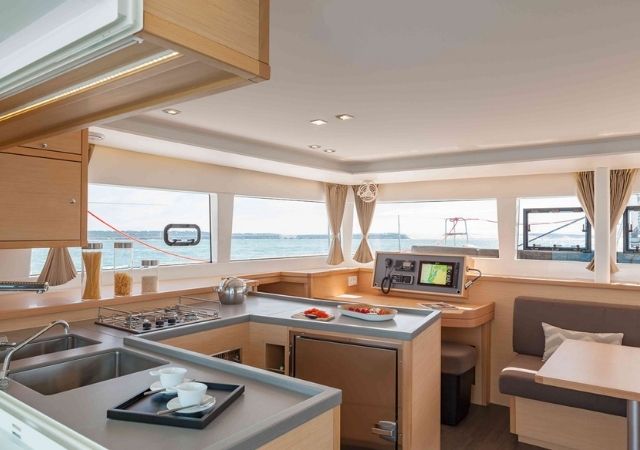
Aboard the Lagoon 450F, the vertical saloon windows and a U-shaped galley create a roomy working space in the saloon.
Why buy a Lagoon 450 Used?
Pre-owned boats usually represent a better value. Someone else has already paid for the initial depreciation and insurance rates are lower. Many of the Lagoon 450s were upgraded by private owners with electronics and extra refrigeration while the charter models received regular maintenance because they worked so hard in rental service. The 450 was a workhorse for Lagoon that was built for nine years, so there are plenty of used ones on the secondary market and you’ll find a strong network of owners to help you get to know the model better.
Conclusion
Lagoon builds boats for charter as well as private ownership and their early flybridge versions were popular with big groups on vacations while the sedan “S” versions sold about 70 percent to private owners. In 2020, Lagoon switched strategy and introduced the Excess line that targeted sportier sailing for private use while their flybridge models morphed into semi-fly designs with a low lounge next to a bulkhead-mounted helm station. These mid-fly designs are a best-of-both worlds compromise, and there are no more “S” or “F” versions built today.
The base price of the Lagoon 450 S in 2017 was $430,000 and well-equipped, it was closer to $615,000. The 450 F was about $100,000 more on both, but time will have put significant pricing pressure on these models. Overall, the Lagoon 450 did well and many hulls were launched primarily because the model found the sweet spot in the mid-forty-foot range that cruisers love. The key is to find which version works best for your type of sailing and then pursue finding one with gusto.
Specifications:
Designer: Van Peteghem Lauriot Prevost (VPLP)
LOA: 45'10"
LWL: 43'11"
Beam: 25'10"
Draft: 4' 3"
Sail Area: 1,399/1421 sq.ft.
Displacement (light): 33,057 S / 34,178 F lbs.
Water: 92 gal.
Fuel: 275 gal.
Mast Height: 73' 3"
Headroom in saloon: 6’ 9”
Engines: Twin 45-hp or 57-hp Yanmar diesels

